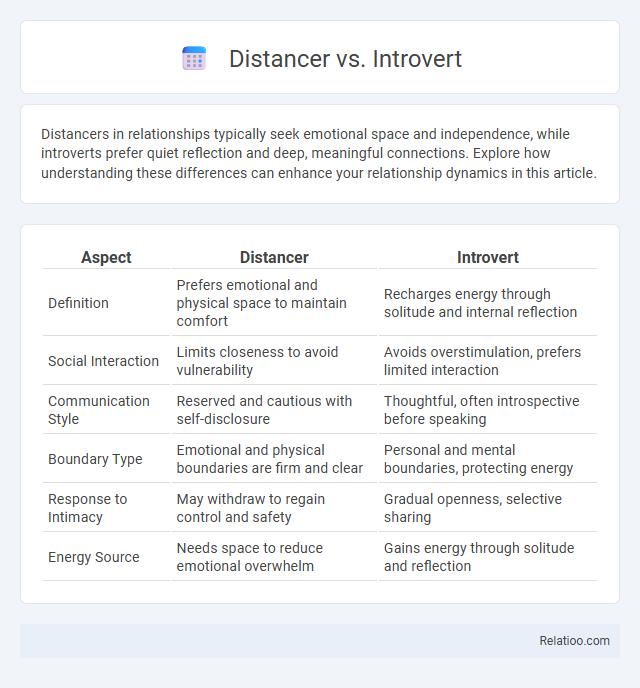Distancers in relationships typically seek emotional space and independence, while introverts prefer quiet reflection and deep, meaningful connections. Explore how understanding these differences can enhance your relationship dynamics in this article.
Table of Comparison
| Aspect | Distancer | Introvert |
|---|---|---|
| Definition | Prefers emotional and physical space to maintain comfort | Recharges energy through solitude and internal reflection |
| Social Interaction | Limits closeness to avoid vulnerability | Avoids overstimulation, prefers limited interaction |
| Communication Style | Reserved and cautious with self-disclosure | Thoughtful, often introspective before speaking |
| Boundary Type | Emotional and physical boundaries are firm and clear | Personal and mental boundaries, protecting energy |
| Response to Intimacy | May withdraw to regain control and safety | Gradual openness, selective sharing |
| Energy Source | Needs space to reduce emotional overwhelm | Gains energy through solitude and reflection |
Understanding the Terms: Distancer vs Introvert
The distinction between Distancer and Introvert lies in their social behavior and emotional regulation; Distancers typically create space in relationships to manage stress, while Introverts recharge by seeking solitude and prefer quieter environments. Understanding your tendencies as a Distancer or Introvert can improve communication and empathy in personal and professional relationships. Knowing these differences helps you recognize how you manage social interactions and emotional needs effectively.
Key Psychological Differences
Distancers tend to maintain emotional distance and withdraw during conflicts, valuing personal space and autonomy, while introverts prefer solitude to recharge but may still seek meaningful connections. Your interaction style as a distancer is characterized by a desire to avoid emotional overwhelm, contrasting with introverts whose quiet nature stems from sensitivity to external stimuli. Key psychological differences lie in coping mechanisms: distancers manage stress by pushing others away, whereas introverts handle it through introspection and limited social engagement.
Origins and Influences: Nature vs Nurture
Distancers often develop traits influenced by both genetic predispositions and early environmental factors, showing a balance between nature and nurture. Introverts primarily inherit neurological patterns that favor introspection, but social experiences and upbringing also shape their behavior significantly. Distancers, while similar to introverts in seeking solitude, may display emotional withdrawal rooted more in learned responses to trauma or relational dynamics than innate temperament.
Social Interaction Patterns
Distancers maintain emotional and physical boundaries, often appearing reserved in social settings, which differs from introverts who may seek solitude to recharge but still value close social connections; this subtle distinction impacts how you interpret their social interaction patterns. Introverts engage selectively, preferring deep, meaningful conversations over large gatherings, whereas distancers might keep interactions brief and less emotionally involved to protect personal space. Understanding these nuanced behaviors helps tailor your approach for more effective communication and relationship-building with each personality type.
Emotional Responses and Needs
Distancers, Introverts, and Avoidants each exhibit unique emotional responses and needs that influence their interactions. Distancers often seek autonomy and may suppress emotions to maintain space, while Introverts require solitude for recharging and prefer deep, meaningful connections. Your understanding of these differences helps tailor communication approaches that respect individual emotional boundaries and support healthy relationships.
Communication Styles Compared
Distancers communicate by maintaining emotional and physical space, often using indirect language to avoid conflicts, while introverts prefer thoughtful, reserved communication, focusing on depth rather than breadth in interactions. Both tend to limit social exposure, but distancers actively push others away to protect themselves, whereas introverts recharge through solitude and careful dialogue. Understanding these distinct communication styles aids in navigating relationships by recognizing the need for space versus depth in conversations.
Impact on Relationships
Distancers tend to create emotional space that can lead to misunderstandings, while introverts often withdraw to recharge, which may be misinterpreted as disinterest by their partners. Your ability to recognize these differences helps in managing expectations and fostering healthier communication. Distancers' need for independence, contrasted with introverts' preference for solitude, impacts relationship dynamics by influencing how each processes stress and connection.
Coping Mechanisms and Self-Care
Distancers maintain emotional boundaries to protect themselves, often using solitude as a coping mechanism, while introverts recharge through quiet reflection and limited social interactions. Your self-care should include setting healthy boundaries for distancers and creating peaceful environments for introverts to prevent overwhelm. Understanding these differences helps tailor strategies like mindfulness, journaling, or controlled social exposure to support emotional well-being effectively.
Misconceptions and Stereotypes
Distancers are often mistaken for introverts due to their preference for solitude, but Distancers primarily maintain emotional and physical distance, while introverts recharge through solitude without necessarily seeking detachment. Misconceptions link Distancers to aloofness or lack of empathy, ignoring their strong internal boundaries that protect emotional well-being. Understanding the nuances between Distancer, introvert, and other relational styles helps you avoid stereotyping and promotes more accurate interpersonal interactions.
Recognizing Yourself: Distancer, Introvert, or Both?
Recognizing whether you identify as a Distancer, Introvert, or both involves understanding key behavioral traits: Distancers often maintain emotional space and may withdraw during conflicts, while Introverts typically recharge through solitude and prefer less stimulation. Both types value personal boundaries but differ in motivation--Distancers seek control over proximity, whereas Introverts focus on inner energy preservation. Accurate self-identification helps improve communication and relationships by tailoring responses to emotional needs and interaction preferences.

Infographic: Distancer vs Introvert
 relatioo.com
relatioo.com